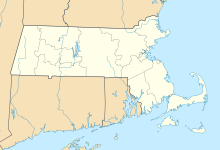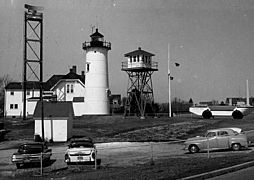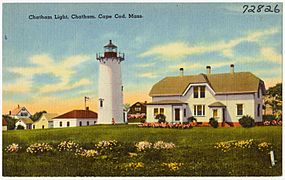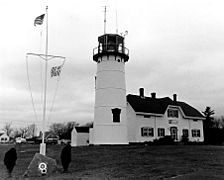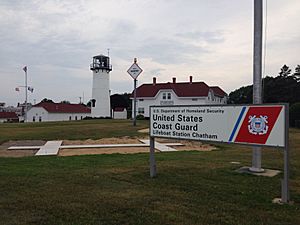Chatham Light facts for kids
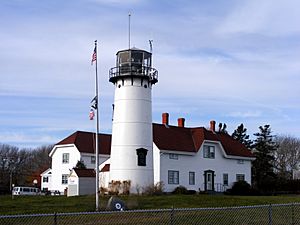 |
|
| Chatham Light and Coast Guard Station (2007) | |
|
|
|
| Location | Chatham, Massachusetts |
|---|---|
| Coordinates | 41°40′16.704″N 69°57′.554″W / 41.67130667°N 69.95015389°W |
| Year first constructed | 1808 |
| Year first lit | 1877 (current structure) |
| Automated | 1982 |
| Foundation | Concrete |
| Construction | Cast iron plate with brick lining |
| Tower shape | Conical |
| Markings / pattern | White with gray lantern |
| Focal height | 80 feet (24 m) |
| Original lens | 4th order Fresnel lens |
| Current lens | Carlisle & Finch DCB-224 |
| Range | 24 nautical miles (44 km; 28 mi) |
| Characteristic | Fl (2) W 10s, lighted continuously |
| Fog signal | none |
| Admiralty number | J0394 |
| ARLHS number | USA-158 |
| USCG number | 1-525 |
The Chatham Lighthouse, also known as Twin Lights for a long time, stands tall in Chatham, Massachusetts. It is located near the "elbow" of Cape Cod. This lighthouse helps guide ships safely.
The first lighthouse here was built in 1808. It had two wooden towers. People wondered why two towers were needed instead of just one. In 1841, new wooden towers replaced the old ones. Later, in 1877, two new towers made of strong cast iron were built. One of these towers was later moved in 1923. It became the Nauset Light in a different area called Eastham.
Contents
History of Chatham Light
The Chatham Light station began in 1808. It was the second lighthouse built on Cape Cod. To make it different from Highland Light, the first Cape Cod lighthouse, and to help ships find their way, two towers were built. These towers were octagonal, meaning they had eight sides, and were 40-foot (12 m) tall. They were even built on special skids. This allowed them to be moved if the entrance channel to the harbor changed.
President Thomas Jefferson chose Samuel Nye as the first Keeper of the Chatham Lights. He started his job on October 7, 1808. The lighthouse has a very interesting story over the years.
Key Moments in the Lighthouse's History
- 1841: The original wooden towers were replaced. Two new 40-foot (12 m) brick towers were built instead.
- 1857: Special lenses called Fresnel lenses were put in. These lenses were powered by lard oil to make the light brighter.
- 1877: New twin towers were built further from the shore. These were made of cast iron with brick inside. A new house for the keeper was also built. This was done because the land near the old towers was wearing away due to erosion.
- 1893: A brick building was added to store oil for the light.
- 1923: The northern tower of the two was moved. It traveled about 12 miles (19 km) north to become Nauset Light.
- 1939: Chatham Light, which had used kerosene since 1882, was changed to run on electricity. The light stayed on and active during World War II.
- 1969: The old Fresnel lens was moved to a museum. A new, very bright rotating light was installed. This new light produced over 2.8 million candlepower.
- 1982: The lighthouse became automated. This means it no longer needed a keeper to operate it every day.
- 1983: Modern Aerobeacons were put into the lantern room.
- 1993: Even newer DCB-224 aerobeacons were installed.
Chatham Light was added to the National Register of Historic Places on June 15, 1987. It is listed as the Chatham Light Station.
Light Keepers Who Worked Here
Many dedicated people worked as the main light keepers at Chatham Light over the years. They made sure the light was always shining to guide ships. The first keeper was Samuel Nye, who started in 1808. The last principal keeper listed was George T. Gustavus, who worked until 1945.
Chatham Light Today
Today, the building that used to be the keeper's house is still very active. It is now a U.S. Coast Guard station. Coast Guard members live and work here. They carry out important missions like search and rescue operations. They also help enforce maritime laws and work on Homeland Security tasks. A group called Flotilla 11-01, which is part of the U.S. Coast Guard Auxiliary, also operates from this station.


